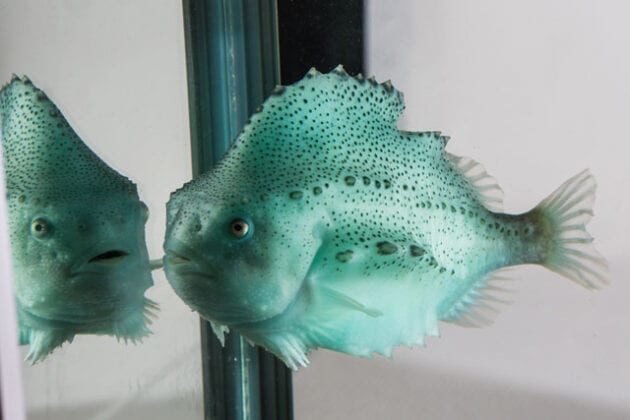Worth to know about cleaner fish such as lumpfish and ballan wrasse

Cleaner fish are an important tool for combating salmon lice. Farmed ballan wrasse, lumpfish and other wild wrasse species feed on sea lice on salmon.
Content
It is important to develop and apply knowledge of the different species to make them effective as lice eaters while at the same time ensuring their well-being. Here we summarise the current knowledge on production, fish welfare, nutrition and breeding, and present five things you should know about cleaner fish.
Use a species and size suitable for the location
Ballan wrasse thrive at relatively high temperatures, which means that the Trøndelag region is the northernmost region which they are suitable for, especially due to the low winter temperatures. Lumpfish are happier and work well at lower temperatures, and are therefore better suited for use further north. However, at high summer temperatures, lumpfish often experience higher rates of disease and mortality.
Lumpfish and ballan wrasse have different anatomies, physiologies and behaviours. Both are robust fish with low mortality rates, solid health and good nutritional levels, which is a prerequisite for the species to thrive in the salmon net-pens and feed on salmon lice.
Ballan wrasse is usually a more efficient sea lice eater than lumpfish, and quickly starts feeding on the lice after being introduced to the net-pen. If the ballan wrasse stays healthy and in good shape throughout the autumn, it can be an effective cleaner fish at lower temperatures as well.
Ideally, the cleaner fish follow the salmon in the net-pen throughout the entire production cycle. Ballan wrasse grows slowly and can therefore be used for an entire cycle, and if it stays healthy and fit, it can be set out with large salmon. Proper nutrition is key to achieving this. They need to be fed in the net-pens, which might make it necessary to adapt both the feeding method and feed consistencies for each individual species. Lumpfish grow significantly faster than ballan wrasse, which can be a problem if they grow too big during the production cycle.
Farmed cleanerfish is best suited for a life in net-pens
Wild-caught fish are not adapted to life in a net-pen. They are prone to severe stress and may carry infections with them from the area in which they were caught. Controlled infection studies show that ballan wrasse can be a reservoir for, among other things, the infectious pancreatic necrosis (IPN) virus. If ballan wrasse and salmon coexist, it is therefore a potential for viral transmission. Lumpfish are also prone to a number of other diseases, though ballan wrasse appear to be less susceptible to disease than lumpfish. Currently, farmed cleaner fish are often used along with wild-caught wrasse species, which presents a high risk of transmitting disease from wild to farmed cleaner fish. Farmed fish can be vaccinated before they are transferred to net-pens, which reduces the risk of outbreaks of specific diseases. Utilising only farmed and vaccinated cleaner fish would increase the possibility for improving their overall health and well-being.
Nofima scientists are working on collecting sufficient data for successful breeding of lumpfish families with a particular appetite for salmon lice. Feeding on salmon lice is in fact a genetically conditioned trait, and so Nofima’s breeding programme has focused on breeding a fish that will thrive and also be resistant to the bacterial disease vibriosis and atypical furunculosis. It is best to use families that have steady growth as broodstock.
Ballan wrasse production must increase
The goal for the aquaculture industry is to become self-sufficient with farmed cleaner fish. Even though ballan wrasse is regarded as the most efficient salmon lice eater, the production of farmed ballan wrasse is currently insufficient to meet demand in the areas it is best suited for. It is more difficult to breed in its early life stages than lumpfish is, among other things because it undergoes a typical marine larval stage where it is dependent on live feed. This is why, wild-caught wrasse or farmed lumpfish are often used in net-pens where farmed ballan wrasse would have been better. New knowledge that could help increase the production and quality of ballan wrasse would therefore be extremely useful, particularly in terms of reproduction, initial feeding and various environmental requirements.
We need to know how to best feed the cleaner fish to ensure its survival and its ability to become an effective lice feeder. Sea lice are more of a “snack” and do not provide enough nutritional value for the cleaner fish. The ballan wrasse has proven to be an exceptionally picky eater, especially in the early phase, so we are currently producing feed for ballan wrasse using high-quality ingredients originally intended for human consumption, such as shrimp and krill oil, which makes ballan wrasse feed extremely expensive.
We need to produce high-quality fry
A good sea lice eater is fit and healthy. Companies that produce cleaner fish must therefore know what the fish need to thrive, grow and stay healthy when they are placed in a net-pen. They need to have knowledge about the different species’ needs, optimum feed and feeding practices, space requirements and how to ensure good water quality. Dedicated farmers are key to succeeding with the production of high-quality fry.
Ballan wrasse do not thrive in strong water currents. They are sometimes observed huddling together in the tanks, and stress is assumed to be causing this behaviour. Ballan wrasse are also very sensitive to being handled, and it is therefore important to create a calm environment with as few disturbances as possible.
Lumpfish, on the other hand, have a body shape that makes it a less able swimmer, and it needs to rest from time to time. For that purpose it uses a sucker on its belly to attach to the tank walls or other available surfaces. Lumpfish fry can be aggressive towards other fry by snapping at their tails. It is important that the feed is supplied where the fish actually is, such as along the tank walls during the periods where they tend to attach to the walls to rest. Many breeders use dispensers located at the centre of large tanks, which can be too far away for small lumpfish. In addition, the feed pellets must be large enough for the largest lumpfish and small enough for the smallest. Unlike ballan wrasse, lumpfish eat almost any feed that is available to them, and they grow fast throughout their entire life. This is not necessarily a good thing, as rapid growth requires more feed, and a shortage of certain nutrients can easily occur.
It has been claimed that lumpfish that grow rapidly become aggressive and “bully” smaller fish by biting their tail or back fins. Lumpfish are therefore usually sorted by size many times before being transferred to pens in the sea. However, research has shown that unsorted lumpfish can live close to their neighbours without abusive behaviour as long as there is a healthy environment in the tank and all fish have access to a sufficient amount of feed of the right size.
Under the right environmental conditions, lumpfish will have good growth and stay healthy.
Knowledge must be applied and shared
There has been a rapid increase in the use of cleaner fish in the salmon industry, and to reduce the currently high mortality levels, it is important to adhere to guidelines, while applying and sharing existing knowledge.
Nofima and its partners have gathered scientific and practical knowledge to enable farmers to assess the state of fish welfare in their net-pens and to improve it. This requires a number of tools called welfare indicators, and we have gathered such tools for lumpfish and ballan wrasse in a fact sheet series which you can download here:
These fact sheets are useful for anyone working with lumpfish or ballan wrasse. Too many indicators have been suggested to mention all of them here, but examples include oxygen and temperature levels, mortality and behavioral characteristics.
The tools are based on knowledge about individual fish, fish as a group and the environment in which they live. The fact sheets are an introduction to operational and laboratory-based welfare indicators for cleaner fish.
Do you want to know more?
To gain more knowledge about cleaner fish, please search our publication archive for words like cleaner fish, lumpfish and ballan wrasse.
Research areas


